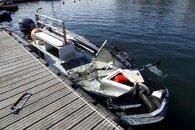descent
Contributor
This afternoon, I spent an unusually long time waiting on hold, listening to that awful muzak.
Here's a translation, re-edited closer to US standards.
Three seriously injured by oxygen tank explosion aboard dive boat
They left to explore the sea. They came back scared stiff, nursing serious injuries.
Saturday morning around 9:30 AM, a group of 5 divers started a trip off Carry-le-Rouet [along the Côte d'Azur near Marseille, département Bouches-du-Rhône].
Clear skies. Great viz. A fine day for diving.
Suddenly, one of the oxygen tanks aboard the 20 foot rigid hull inflatable boat exploded, according to the regional daily, La Provence.
Three of the five divers were hurt. One suffered a broken leg and facial trauma. A second received facial burns. The third victim received only minor injuries. [-]They were taken to the hospital by firefighters[/-]. The seriously injured were airlifted to the hospital by helicopter. No further information about their medical condition is available.
This rare accident has alarmed and upset the entire port of Carry-le-Rouet. A fundamental question remains: how can an oxygen bottle simply explode?
These bottles are used on board to oxygenate the divers in case of decompression sickness. They are subject to regular checks, and need to be replaced every 5 years, according to the regional daily.
An expert analysis of the bottle should provide more information on the reasons for the accident.
A police investigation has been opened.

Update(s):
1) ... D'après les premiers éléments d'informations recueillis auprès de témoins, il s'agirait d'une bouteille d'air qui aurait explosé. ... According to initial information gathered from witnesses, it would have been an air cylinder that exploded.
Here's a translation, re-edited closer to US standards.
Three seriously injured by oxygen tank explosion aboard dive boat
They left to explore the sea. They came back scared stiff, nursing serious injuries.
Saturday morning around 9:30 AM, a group of 5 divers started a trip off Carry-le-Rouet [along the Côte d'Azur near Marseille, département Bouches-du-Rhône].
Clear skies. Great viz. A fine day for diving.
Suddenly, one of the oxygen tanks aboard the 20 foot rigid hull inflatable boat exploded, according to the regional daily, La Provence.
Three of the five divers were hurt. One suffered a broken leg and facial trauma. A second received facial burns. The third victim received only minor injuries. [-]They were taken to the hospital by firefighters[/-]. The seriously injured were airlifted to the hospital by helicopter. No further information about their medical condition is available.
This rare accident has alarmed and upset the entire port of Carry-le-Rouet. A fundamental question remains: how can an oxygen bottle simply explode?
These bottles are used on board to oxygenate the divers in case of decompression sickness. They are subject to regular checks, and need to be replaced every 5 years, according to the regional daily.
An expert analysis of the bottle should provide more information on the reasons for the accident.
A police investigation has been opened.

Update(s):
1) ... D'après les premiers éléments d'informations recueillis auprès de témoins, il s'agirait d'une bouteille d'air qui aurait explosé. ... According to initial information gathered from witnesses, it would have been an air cylinder that exploded.
Last edited:





